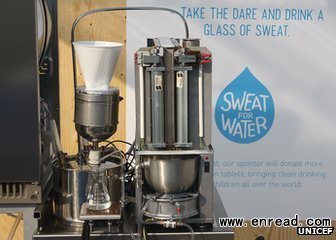| ||||||||||||||||||||||||||||||||||||||||||||||||||||||||||||||||
|
在瑞典,一部能够从浸满汗水的衣服上提取出安全纯净饮用水的汗水提取机进入了人们的视线。这部机器通过高速旋转和加热待提取的衣服,从而使汗水变成蒸汽与衣物分离,再经过一层特殊设计的过滤网,让水分子得以通过,而细菌、衣物纤维等物质被隔离开来,如此就提取到了据称比当地自来水还要清洁的饮用水。
 The sweat-extraction machine was developed to promote a campaign by Unicef in Sweden A machine that takes sweat-laden clothes and turns the moisture into drinking water is in use in Sweden.
The device spins and heats the material to remove the sweat, and then passes the vapour(水蒸汽) through a special membrane1 designed to only let water molecules2 get through.
Since its Monday launch, its creators say more than 1,000 people have "drunk other's sweat" in Gothenburg.
They add the liquid is cleaner than local tap water.
The device was built for the United Nation's child-focused charity Unicef to promote a campaign highlighting the fact that 780 million people in the world lack access to clean water.
The machine was designed and built by engineer Andreas Hammar, known locally for his appearances on TV tech show Mekatronik.
He said the critical part of the sweat machine was a new water purification component3 developed by a company named HVR in collaboration4 with Sweden's Royal Institute of Technology.
"It uses a technique called membrane distillation(蒸馏)," he told the BBC.
"We use a substance that's a bit like Gortex that only lets steam through but keeps bacteria, salts, clothing fibres and other substances out.
"They have something similar on the International Space Station to treat astronaut's urine - but our machine was cheaper to build.
Volunteers have been sampling the treated sweat since the start of the week in Gothenburg
"The amount of water it produces depends on how sweaty the person is - but one person's T-shirt typically produces 10ml [0.3oz], roughly a mouthful."
The kit5 has been put on show at theGothia Cup - the world's largest international youth football tournament.
MattiasRonge, chief executive of Stockholm-based advertising6 agency Deportivo - which organised the stunt7 - said the machine had helped raise awareness8 for Unicef, but in reality had its limitations.
"People haven't produced as much sweat as we hoped - right now the weather in Gothenburg is lousy," he said.
"So we've installed exercise bikes alongside the machine and volunteers are cycling like crazy.
"Even so, the demand for sweat is greater than the supply. And the machine will never be mass produced - there are better solutions out there such as water purifying pills."
点击  收听单词发音 收听单词发音
|
||||||||||||||||||||||||||||||||||||||||||||||||||||||||||||||||
上一篇:机遇号发现火星曾存在水的证据 下一篇:英国科学家利用尿液发电 |
||||||||||||||||||||||||||||||||||||||||||||||||||||||||||||||||
- 发表评论
-
- 最新评论 进入详细评论页>>



